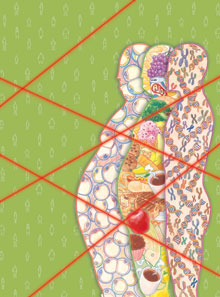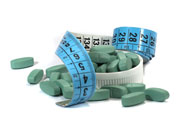New Devices Zap Excess Pounds, but Are They Safe?
By Tara Hulen
 |
Fat-zapping lasers and other new technologies offer appealing nonsurgical options for weight loss, but the techniques may not be for everyone. |
For every woman who has squeezed into torturously tiny shapewear and every man who wants to flatten a fleshy spare tire, fantasy has now become reality. Two new devices recently approved by the U.S. Food and Drug Administration can cause fat cells to die and disappear, along with an inch or so of bulges. But they aren’t for everyone, a UAB expert says.
Zeltiq freezes fat cells and causes them to shrivel and die over several months; Zerona uses low-level laser therapy to purge fat from surface-level cells over a period of weeks. The treatments don’t produce the same results as liposuction, but they offer a noninvasive option to smooth small trouble spots without any incisions, anesthesia, or downtime, and typically they are less expensive than surgery.
Where Did It Go?
UAB weight-loss specialist Jamy Ard, M.D., says these machines are not the answer for patients fighting true obesity, but they could be useful for others. “These types of products are designed for ‘spot contouring,’” Ard says. “They’re for people who want to lose a muffin top or take a couple of inches off the bikini line.” The devices are typically approved for people who have a body mass index below 30, he notes.
|
Slim Chances for Diet Pills? Concerns over side effects have long been an issue for diet drugs, but could high standards negatively impact future research into obesity-treating drugs? |
Based on the data he has reviewed, “these therapies look to be reasonably safe,” Ard says. But he would like to see more research into manufacturers’ claims that the fat released is harmlessly expelled or reabsorbed by the body. “The laser therapy, for example, basically emulsifies the fat,” Ard notes. “The fat is being released, but where does it go? It’s got to go somewhere. Even if the cell dies, the lipid doesn’t just dissipate. It’s an energy source, and that energy has to be either used or stored.”
Beneath the Surface
Zeltiq and Zerona attack subcutaneous fat cells, close to the surface of the skin, which might not always look pretty but aren’t a health threat. However, skeptics wonder whether that fat, when released, is converted to visceral fat over time. Visceral fat can lead to heart problems, high blood pressure, and diabetes.
Ard is also concerned that the released fat may raise triglyceride levels. The manufacturers say any increase would not reach dangerous levels, comparing the effects to eating four or five French fries a day. But “the volume of fat—if you’re talking about three inches of circumference on average (one inch each from belly, hip, and thighs)—sounds like more to me than four to five French fries,” Ard says.
What Works
Even for relatively thin people with just a few bulges they’d like to zap, Ard says the machines aren’t the best first option. “To get the most overall benefits, work with an exercise trainer, and get someone who has some experience working with an individual like yourself, no matter what your fitness level is,” he explains. This approach is especially important for people with issues such as previous injuries, bad knees, or back problems. “That’s the best way to go because it pays more dividends than just shaving off a couple of inches here or there.”
People who have multiple health issues and need to lose a larger volume of weight should “enter a good medically managed program, like our UAB EatRight programs,” Ard adds. “We have a number of options for people based on the amount of weight they need to lose, their resources, and their relationship with food.”
More Information
Learn more about UAB's EatRight program
